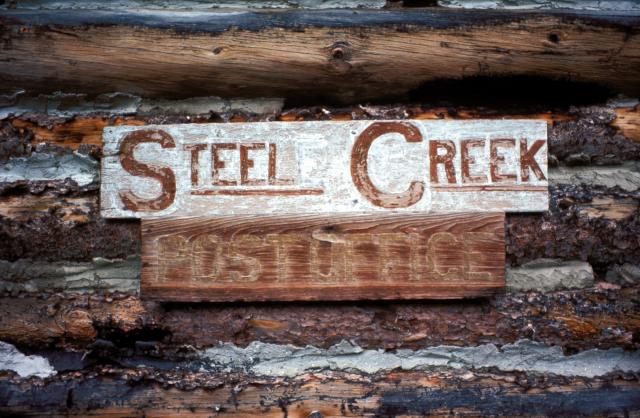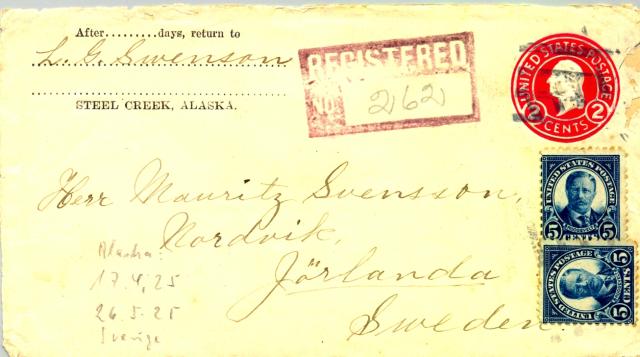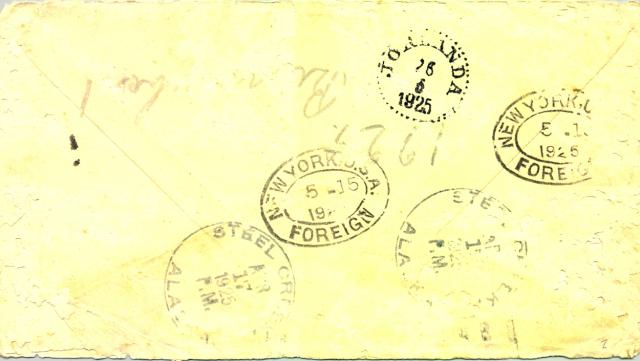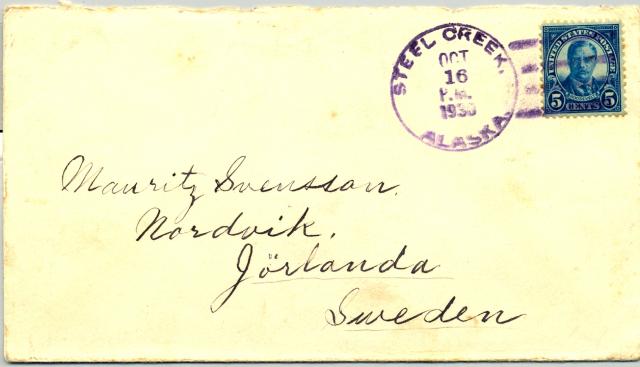You are viewing ARCHIVED content published online before January 20, 2025. Please note that this content is NOT UPDATED, and links may not work. Additionally, any previously issued diversity, equity, inclusion or gender-related guidance on this webpage should be considered rescinded. For current information, visit https://www.blm.gov/blog.
Steele Creek or Steel Creek?

In 1909, a report of the United States Geological Survey (USGS) mentioned “Steele Creek,” Alaska. Yet, an earlier 1898 USGS report referred to miners at “Steel Creek” in what was becoming the Steele Creek community in the Fortymile River drainage of eastern Alaska. The spelling “Steele Creek” is accepted today for this community and is used for the Steele Creek Roadhouse.
However, visitors to this historic place managed by the Bureau of Land Management Alaska (BLM) may notice something odd. The old sign for the post office that closed in 1951 says “Steel Creek.” A close look at that sign shows that it originally said “Steele Creek” but was later modified to remove the last “e.”
So, what‘s going on?
Some of the answer is found in records of the United States Post Office, including who the postmasters were and when they were appointed at this post office.
Steel Creek Post Office Timeline:
1907: George W. Lenont was appointed the first postmaster for the new post office of “Steel Creek,” Alaska on April 11, 1907.
1908: John A. Kemp was appointed the second postmaster for the “Steel Creek” Post Office on April 28, 1908.
1909: For a few weeks in the summer of 1909, mail was discontinued to the “Steel Creek” Post Office with mail instead directed to the Jack Wade, Alaska Post Office, over 10 miles to the south. But that soon changed perhaps due to local uproar for the inconvenience to area residents of losing their post office.
1909: The “Steel Creek,” Alaska Post Office resumed operation with the reappointment of John A. Kemp as postmaster on September 11, 1909. He served into the early 1930s and operated the roadhouse along with his wife. He was the longest-serving postmaster for the Steel Creek Post Office.
1932-1951: Following Kemp, six other people, including two women, were appointed for shorter periods of time as postmaster for “Steel Creek,” Alaska.
1949: Mrs. Ruth E. Wilson, was the last appointed postmaster of “Steel Creek,” Alaska on August 29, 1949, and would serve for about two years.
1951: On August 31, 1951, mail for the now-closed “Steel Creek” Post Office was directed to the Boundary, Alaska Post Office, over 25 miles to the southeast.
The story of Steele Creek area gold rush miner Lawrence G. Swenson and 1925 and 1930 postmarks from the Steel Creek Post Office (photos courtesy of Robert King)
Shown are two examples of early postmarks on mail sent from the Steel Creek Post Office by long-time local gold miner, Lawrence G. Swenson. At the time, John A. Kemp was postmaster and the postmarks shown here were likely hand-stamped by him or his wife within the log post office.
Lawrence, the sender of the two letters, had been born in Sweden on March 4, 1876, under the name “Lars Gustave Svensson,” which he later changed after coming to America. He arrived by boat at New York City on March 30, 1900, being the only member of his family to leave Sweden. Lawrence’s mother had died in 1899 and his father would die in 1906, leaving Lawrence’s older brother Olaf Mauritz Svensson (1872-1937) as the head of the family in Sweden. It was to this brother that Lawrence sent the letters in 1925 and 1930 from Steel Creek, Alaska.
A closer look at the surviving envelopes of the two letters suggests an interesting story about communication in the early 20th century between the relatively remote Steele Creek region of Alaska Territory and the outside world.

April 17, 1925 Steel Creek, Alaska postmark: This postmark is on a registered letter that likely contained an international postal money certificate enabling Lawrence to send money to his brother in Sweden. The cost for mailing it registered was 12 cents. And for that price, his letter received special tracking as shown by additional postmarks added to the back side of the envelope.

Two Steel Creek postmarks dated April 17, 1925, were stamped over the flap on the back side of the envelope showing when Lawrence mailed his letter. The was done to help determine if the registered letter had been illegally opened in transit to it destination. Likely it could not have been resealed without disturbance of the added postmarks. Then two New York City postmarks dated May 15, 1925, were added also to the back side of the envelope when it reached that city. These postmarks also recorded that Lawrence’s letter was for a foreign country. Finally, a May 26, 1925, postmark was added to the back of the envelope showing that it arrived at its final destination in Sweden on that date. This was after leaving Alaska over five weeks earlier including traveling by boat for over a week in crossing the Atlantic Ocean.

October 16, 1930 Steel Creek, Alaska postmark: This postmark is from another letter that Lawrence Swenson sent to his older brother in Sweden. In this case, was sent unregistered so it cost just the regular postage rate of five cents to Sweden. Consequently, it received no special tracking postmarks to trace its precise arrival date in Sweden. But being just over a month in transit seems likely.
Lawrence undoubtedly sent other letters to his brother Mauritz. And soon after Lawrence learned that Mauritz had died in 1937, he made a trip back to see his remaining family in Sweden after nearly four decades of living in the United States. Lawrence left Steel Creek in July of 1937, and after reaching New York City by train, he sailed on the ocean liner “Kungsholm” on August 19, 1937, to Sweden. He arrived there just over a week later.
But Lawrence stayed only about two weeks in Sweden. On September 9, 1937, he began his return journey to Alaska. He sailed from Goteborg, Sweden on the boat “Drottningholm” arriving back in New York City on September 18, 1937. The short trip was likely due to wanting to return to the Steele Creek community before the onset of severe winter weather. Also, Lawrence may have needed to finish up his mining operation for the 1937 season.
Earlier, on October 23, 1918, as a resident of “Steel Creek, Alaska,” Lawrence had reported that he was a gold miner when he registered for the draft during World War I. He did this at Eagle, Alaska, and stated that his older brother Mauritz in Sweden was his “nearest relative.” That record further noted that Lawrence was neither married nor a United States citizen in 1918. Later federal census records for 1920 and 1930 also listed him as mining in the Steele Creek region.
When the 1940 federal census was taken on November 17, 1939, it again listed Lawrence as living in the Fortymile District, presumably in the Steele Creek area where he was still engaged in mining and prospecting in his mid-60s. Subsequently, it appears that Lawrence remained single and never became a United States citizen before his death in the 1940s.
Early use of the “Steel Creek” spelling
Prior to the establishment of a post office called “Steel Creek, Alaska” in 1907, the name “Steel Creek” was already in use for the small stream that flows northeast for about 7 miles to the Fortymile River. This stream runs near the Steele Creek Roadhouse. But who named it “Steel Creek” and when and why is unclear, but it happened sometime in the 1890s, based on USGS records.
Also unclear is why the added “e” at the end of “Steel” came to be today’s preferred spelling. Some have assumed that the two spellings (“Steel” versus “Steele”) were simply spelling variations. That seems plausible and even likely. Otherwise, it is interesting to note that the name “Steel(e) Creek” has been used elsewhere in Alaska. For example, today, “Steele Creek” is also the name of a census-designated place in the Fairbanks North Star Borough, north of Fairbanks, Alaska.
Sometimes place names simply get carried along from one place to another by settlers wanting to retain familiar names in new settlements. Other times, place names may be connected to some notable quality or feature of the region. (Did someone think that the rock in the vicinity was as hard as steel?)
Also, it is common that place names connect to some noted person or early settler in the region. Thus, some might wonder if there is a connection of the Steele Creek Community name to Sam Steele, a respected officer of the Canadian North-West Mounted Police who served as the head of the Yukon detachment during the Klondike Gold Rush? Currently, the answer is unknown. Perhaps the real story will yet be found!
Robert King, BLM Alaska State Archaeologist & Paleontology Lead
Related Stories
- Using science to uncover mysteries of the Mesa archaeological site in Alaska
- Historic Umtanum Suspension Bridge wins international footbridge award
- Agua Fria National Monument: A desert oasis with a rich history and a vital present
- Alaska's Mineral Men
- Troop 8 feels great about protecting public lands
Office
222 W 7th Avenue #13
Anchorage, AK 99513
United States
